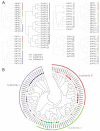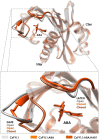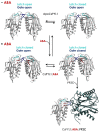An Update on Crop ABA Receptors
- PMID: 34071543
- PMCID: PMC8229007
- DOI: 10.3390/plants10061087
An Update on Crop ABA Receptors
Abstract
The hormone abscisic acid (ABA) orchestrates the plant stress response and regulates sophisticated metabolic and physiological mechanisms essential for survival in a changing environment. Plant ABA receptors were described more than 10 years ago, and a considerable amount of information is available for the model plant Arabidopsis thaliana. Unfortunately, this knowledge is still very limited in crops that hold the key to feeding a growing population. In this review, we summarize genomic, genetic and structural data obtained in crop ABA receptors. We also provide an update on ABA perception in major food crops, highlighting specific and common features of crop ABA receptors.
Keywords: ABA; PYR/PYL; crop; drought; phylogenetic; receptor; structure.
Conflict of interest statement
The authors declare no conflict of interest.
Figures






Similar articles
-
Abscisic acid analogs as chemical probes for dissection of abscisic acid responses in Arabidopsis thaliana.Phytochemistry. 2015 May;113:96-107. doi: 10.1016/j.phytochem.2014.03.017. Epub 2014 Apr 9. Phytochemistry. 2015. PMID: 24726371
-
The selectivity of 6-nor-ABA and 7'-nor-ABA for abscisic acid receptor subtypes.Bioorg Med Chem Lett. 2015 Sep 1;25(17):3507-10. doi: 10.1016/j.bmcl.2015.06.088. Epub 2015 Jul 3. Bioorg Med Chem Lett. 2015. PMID: 26174552
-
Regulatory mechanism of abscisic acid signaling.Biophysics (Nagoya-shi). 2011 Nov 23;7:123-128. doi: 10.2142/biophysics.7.123. eCollection 2011. Biophysics (Nagoya-shi). 2011. PMID: 27857600 Free PMC article. Review.
-
Dewetting Controls Plant Hormone Perception and Initiation of Drought Resistance Signaling.Structure. 2019 Apr 2;27(4):692-702.e3. doi: 10.1016/j.str.2018.12.005. Epub 2019 Jan 24. Structure. 2019. PMID: 30686665
-
Structural insights into PYR/PYL/RCAR ABA receptors and PP2Cs.Plant Sci. 2012 Jan;182:3-11. doi: 10.1016/j.plantsci.2010.11.014. Epub 2010 Dec 7. Plant Sci. 2012. PMID: 22118610 Review.
Cited by
-
Physiological and molecular implications of multiple abiotic stresses on yield and quality of rice.Front Plant Sci. 2023 Jan 11;13:996514. doi: 10.3389/fpls.2022.996514. eCollection 2022. Front Plant Sci. 2023. PMID: 36714754 Free PMC article. Review.
-
Abscisic Acid Affects Phenolic Acid Content to Increase Tolerance to UV-B Stress in Rhododendron chrysanthum Pall.Int J Mol Sci. 2024 Jan 19;25(2):1234. doi: 10.3390/ijms25021234. Int J Mol Sci. 2024. PMID: 38279235 Free PMC article.
-
Integrated transcriptome and methylome analyses reveal the molecular regulation of drought stress in wild strawberry (Fragaria nilgerrensis).BMC Plant Biol. 2022 Dec 28;22(1):613. doi: 10.1186/s12870-022-04006-9. BMC Plant Biol. 2022. PMID: 36575384 Free PMC article.
-
Siberian Wildrye (Elymus sibiricus L.) Abscisic Acid-Insensitive 5 Gene Is Involved in Abscisic Acid-Dependent Salt Response.Plants (Basel). 2021 Jul 2;10(7):1351. doi: 10.3390/plants10071351. Plants (Basel). 2021. PMID: 34371554 Free PMC article.
-
In Dormant Red Rice Seeds, the Inhibition of Early Seedling Growth, but Not of Germination, Requires Extracellular ABA.Plants (Basel). 2022 Apr 9;11(8):1023. doi: 10.3390/plants11081023. Plants (Basel). 2022. PMID: 35448751 Free PMC article.
References
-
- Xu Z.-Y., Lee K.H., Dong T., Jeong J.C., Jin J.B., Kanno Y., Kim D.H., Kim S.Y., Seo M., Bressan R.A., et al. A Vacuolar β-Glucosidase Homolog That Possesses Glucose-Conjugated Abscisic Acid Hydrolyzing Activity Plays an Important Role in Osmotic Stress Responses in Arabidopsis. Plant Cell. 2012;24:2184–2199. doi: 10.1105/tpc.112.095935. - DOI - PMC - PubMed
Publication types
Grants and funding
LinkOut - more resources
Full Text Sources

